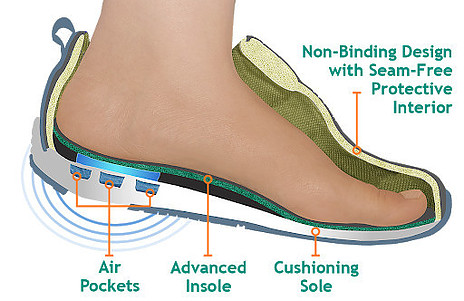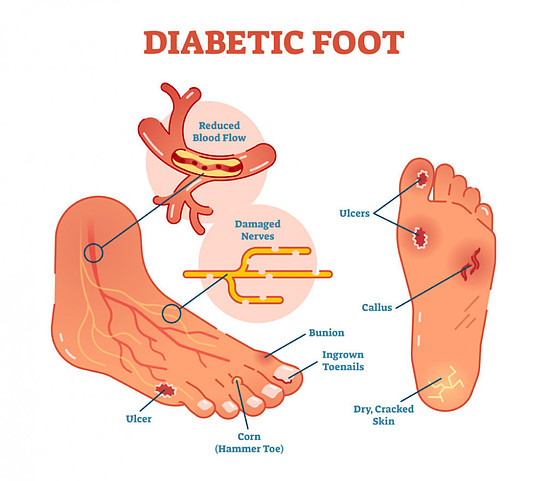People who suffer from Diabetes know only too well that their health is affected, which can sometimes limit their physical well being and daily activities. Wearing specially designed shoes can help reduce the risk and promote healthy circulation in your feet.
The top diabetic shoes for men reduces the pressure and pain of incorrect footwear. They provide good stability and support to your feet, improving your walking, posture, and the ability to help you manage your daily activities and lifestyle better.
Health benefits of wearing diabetic footwear

-
-
- Increased blood flow
- Better posture and stability to your ankle / foot
- Reduced pain to your joints
- Helps reduce pressure around nerves in your foot
- More comfortable for those with foot disorders or deformities
- Wide selection and styles of diabetic shoes available
- Reduces the risk of worsening foot damage occurring
-
Top Diabetic Shoes for Men 2023
1) Dr. Comfort Men’s William-X Double Depth Black Diabetic Casual Shoes
These diabetic shoes are available on Amazon (see price)
These simple and stylish everyday casual diabetic shoes from Dr. Comfort deliver protection and comfort to you all day long. The full-grain leather finish shoe with extra width and depth, provides perfect support for anyone with diabetes or other foot health concerns.
Pros
-
-
- Has a seamless leather interior lining which shapes around so it won’t cause irritation to your feet.
- The hook-and-loop closure allows for easy adjustability and personalized comfort.
- Has extra width and depth in the toe box and forefoot which prevents you from stubbing your toes and reduces the pressure on your feet.
- Firm padded heel support and padded tongue which reduces irritation.
- Has a supportive polyurethane orthotic insole that is removable so you can fit whichever one you choose.
- Non skid lightweight sole.
-
Cons
-
-
- If you are a wide fit in other shoes then you may need to get a regular size as these are quite a wide fit.
-
CLICK HERE TO BUY NOW
2) Dr. Comfort Wing Men’s Therapeutic Diabetic Extra Depth Dress Shoes
These diabetic shoes are available on Amazon (see price)
The Dr. Comfort Wing shoe is designed with full-grain leather and a hand-burnished finish giving you a classic style that is built for comfort and versatility. The fine details of this elegant diabetic dress shoe makes it a perfect addition for any occasion.
Pros
-
-
- A high quality durable leather fit that will help prevent wear and tear.
- Traditional lace up fit that makes the shoes perfect for those formal occasions when you want to look smart but not compromise comfort.
- Lightweight with a very comfortable cushioned support when walking.
- The protective toe box provides extra protection from stubbing your toes.
- Comfortable padded heel that doesn’t rub or irritate your skin.
-
These shoes are often recommended for diabetes, neuropathy, arthritis, plantar fasciitis, pronation, metatarsalgia, morton’s neuroma, bunions, corns and hammer toes.
Cons
-
-
- Some people may prefer a Velcro adjusting clasp to the conventional lace up look.
-
CLICK HERE TO BUY NOW
3) Orthoshoes Mens Diabetic Wide Fitting Mesh Walking Shoes
These diabetic shoes are available on Amazon (see price)
These wide fitting diabetic men’s shoes have a breathable lightweight mesh and easily adjustable Velcro clasp to ensure a comfortable fit. The stylish design Ortho shoes can also be worn around the house as slippers and are available in a choice of attractive colours.
Pros
-
-
- Feel really lightweight that you could wear either inside as slippers or outside as shoes.
- Stretchable mesh that expands with your feet when you walk.
- Removable and washable memory foam inserts.
- Durable anti-skid grip that keeps you confidence that you are safe on your feet.
- The Velcro clasp makes them easy to fasten and unfasten.
-
Cons
Some people may find they need a thicker orthotic insole.
CLICK HERE TO BUY NOW
4) Orthofeet Orthopedic Men’s Diabetic Walking Sneaker Shoes
These diabetic sneaker shoes are available on Amazon (see price)
These super comfortable diabetic sneaker shoes will help alleviate stress on your joints, give your feet extra stability and improve your mobility. The lightweight ergonomic sole and air cushioning will help ease the pain on your foot and heel.
Pros
-
-
- Has an extra wide toe box which gives you a comfortable, non-binding fit, and helps ease pressure on sensitive feet and those who suffer with bunions and hammer toes.
- The orthotic sole with extra spacers provides comfort and support for your feet, perfect those who suffer with plantar fasciitis.
- Soft cushioning sole with anti-slip grip.
- Stretchable upper fabric moulds to the shape of your feet.
- Great looking athletic style shoe.
-
Cons
-
-
- They are only available in the one colour design.
-
CLICK HERE TO BUY NOW
5) LongBay Men’s Memory Foam Diabetic Slipper Shoes
These diabetic slippers are available on Amazon (see price)
These Longbay memory foam diabetic slippers have a classical warm knitted upper with terry and plush fleece sock lining that gives them a snug comfortable feel. The large adjustable Velcro strap is perfect for those with sensitive and swollen foot pain.
Pros
-
-
- You are able to machine wash them which makes it perfect to keep clean and care for.
- The slippers have supportive insoles that relax your foot arch that can cause pain, such as plantar fasciitis.
- The hook and loop Velcro strap makes them easy to slip on or off and customise them to the shape of your foot.
- Comfortable memory foam cushions your feet as you walk.
- Good value for money.
-
Cons
-
-
- If you are between sizes or have wide feet then you may need to choose the next size up.
-
CLICK HERE TO BUY NOW
6) Dr. Comfort Stallion Men’s Therapeutic Diabetic Extra Depth Dress Shoe
These diabetic shoes are available on Amazon (see price)
These Dr. Comfort Stallion Men’s Therapeutic Diabetic moccassin-style shoe delivers the perfect business-casual look. With their top grain leather and padded heel and tongue, they provide comfort and support for you every day.
Pros
-
-
- The breathable leather uppers regulate your temperature keeping your feet cool and dry.
- Has a protective toe box that stops you from stubbing your toes.
- Removable insole that allows you to customise the fit by using your own orthotic insert.
- The gel inserts act as a great shock absorber when you are walking.
- Stylish looking shoe that you could either wear both as a casual shoe or dress shoe.
-
Cons
-
-
- Some people with arthritic fingers or poor hand dexterity may struggle with the laces.
-
CLICK HERE TO BUY NOW
What is the difference between normal shoes and diabetic shoes ?
On the outside your regular normal everyday shoes probably don’t look too dissimilar to a pair of specially made therapeutic diabetic shoes.
However, there are some major differences, such as the type of materials used, size, shoe height, depth of shoe and collar size. Here’s a list of the main differences between normal shoes and diabetic shoes for men.

Normal Shoes
-
-
- Made from cheaper materials such as synthetic materials, plastics and rubber.
- Have inner stitching and seams that can rub against your foot.
- Don’t have shock absorbing cushioning.
- No additional padding around heel or toe box of shoe.
- Often made from non breathable materials.
- Non adjustable to alter the fit of the shoe to your foot.
- Don’t tend to be a very deep fit.
- Have a solid heel.
-
Diabetic Shoes
-
-
- Made from natural materials such as leather that is able to stretch.
- Breathable that won’t trap moisture in your feet and are fast drying.
- Have air pockets and shock absorbing cushioning in the heel.
- Additional padding support throughout the shoe.
- Seam free interior to the shoe that won’t rub your feet.
- Have adjustable Velcro attachments to accommodate swollen toes and feet.
- Wider deeper fit.
-
Special features associated with diabetic shoes

Cushioning sole
A lightweight cushioned sole that supports the foot giving you added stability when walking around.
Protective interior
A seam free protective interior made from a soft material that doesn’t cause irritation to your heel, toes or mid foot.
Deep toe box
Increased space around the toe area of the shoe which reduces pressure and provides extra room for your toes to move around inside.
Stretchable fabric
The stretchable fabric of the diabetic shoe ensures that it shapes themselves to the contours of your feet and stop pressure points from occurring.
Extra depth design
Diabetic footwear has extra space that allows you to add insoles or orthotic inserts, as well reducing pressure on often swollen feet allowing them to move freely.
Material used
The material used is very important as it needs to be flexible to accommodate your feet swelling, a common condition which a lot of people with diabetes suffer with. Leather or a mesh design is a good choice as it is able to expand and stretch.
Extra wide fit
It is important that when buying diabetic shoes for men that you consider how wide the shoe should be. Many people with diabetes suffer with oedema and increased swelling to both the feet and ankle. Shoes with an adjustable Velcro attachment are common and help ensure you have a comfortable fit.
Air pockets
The cushioning effect of air pockets helps reduce the stress on your joints and ensures comfortable heel strike when walking.
Orthotic support
Orthotic insoles are helpful reducing pressure sores or excess friction on the foot. They help provide arch support, particularly common in people with over-pronation or fallen arches, offering good cushioning and reduces pressure on the bottom of the foot.
How diabetes affects your feet
Prolonged periods of high blood sugar levels in people with diabetes can cause serious foot complications.
Two of the main foot problems that occur are peripheral vascular disease and diabetic neuropathy.
Foot problems are common with people with diabetes, but by taking good care of your feet every day, and monitoring your blood glucose levels, you can help keep your feet healthier for longer.
Diabetic Neuropathy
Neuropathy is a nerve disorder that is either a motor (nerve damage affecting your muscles), sensory (touch with your hands and feet) or autonomic (involuntary actions such as your heart and digestion) neuropathy.
Diabetic neuropathy occurs in 60-70% of people with diabetes, and is caused by long periods of higher than normal blood glucose levels that damages the nerves.
Associated with the development of nerve damage is a blood fat, triglycerides which is something you have measured when you have a cholesterol check.
The nerve damage causes pain, loss of sensation and feeling to your feet, and tingling feelings. This can lead to sores and cuts developing and being infected leading to ulcers.
Restricted blood flow to your feet leads to poor healing to open wounds and ulcers, which can ultimately lead to chronic wounds, infections and tissue necrosis. This leads to removal or amputation of the dead tissue.
Peripheral Vascular Disease
This is a blood circulation disorder that causes the blood vessels of your veins and arteries outside your brain and heart to become narrow, spasm and eventually completely block.
Peripheral vascular disease causes fatigue and pain in your legs, especially moving around and exercising.
What are the signs and symptoms of diabetic feet
Having diabetes means that you are of a greater risk of developing serious foot problems, so it’s important to check your feet regularly and spot those tell tales signs.
-
-
- Pins and needles (numbness) or tingling sensation.
- Exaggerated sensation to touching things.
- Increased swelling in your feet.
- New sores or wounds that don’t seem to heel.
- Your feet are either very cold or hot.
- A burning pain in your foot.
- Loss of feeling in your feet or legs.
- Cramp in your calves at rest or when mobile.
- Loss of hair on your feet and legs.
- Skin on your feet is smooth and shiny.
- Your feet don’t sweat.
- Loss of feeling in your feet or legs.
- Dull ache in feet.
- Strong foul smell coming from an open wound.
- Any changes in the shape or colour of your feet.
-
The symptoms you experience are often worse at night which can lead to a disrupted sleep pattern.
You may also experience muscle weakness caused by damage to your nerves from elevated blood sugar levels. This can make everyday functional tasks such as standing from a chair or bed more difficult, In addition you may experience co-ordination and balance problems when walking which can put you at higher risk of falling.
Ways to take care of your diabetic feet

1) Never walk around barefoot
If your are in your house always ensure you are wearing slippers or shoes, as it is so easy to scratch or cut your skin.
2) Check your feet daily
Always inspect your feet daily for any changes to them such as increased swelling, redness, new cuts, blisters or nail problems.
3) Always wear clean, dry socks
Change your socks daily and try use ones that won’t make your feet sweat, such as merino wool, that not only will keep your feet warm, but will wick moisture away from the skin. In addition, make sure the socks have extra cushioning to support your feet.
4) Always check your footwear before wearing
Diabetes causes nerve damage in your feet which in turn causes reduced sensation and feeling in your feet. Always check the inside of your shoes or house slippers for loose stones, grit or anything that can potentially cut your feet.
5) Take care when washing your feet
It is important to keep your feet clean and best to wash them daily in lukewarm water. Wash them using a face cloth or sponge, and rather than rubbing them which could make your feet sore, pat them dry taking special care to dry carefully between your toes.
6) Moisturise your feet daily
Use a gentle moisturiser on your feet to prevent dry cracked skin, that if left could cause worsening problems for your feet.
7) Take good care of your nails
Try to keep your nails short but not that short that you could develop ingrowing toenails. Also, keep an eye on them for any signs of developing a fungal infection.
8) Get regular check ups of your feet
It is always a good idea to get a regular examination of your feet by your doctor or podiatrist to ensure you don’t develop any problems.
Top Diabetic Shoes for Men 2023
Most of the common foot problems associated with diabetes in the elderly can be greatly improved by wearing the correct fitting footwear, both in and out of your home.
Wearing a supportive fitting shoe makes it easier to maintain a more natural walking pattern, posture, and prevent unwanted stresses and strains on joints and muscles.
As you get older wearing the right supportive and comfortable footwear is absolutely vital for those suffering with diabetic related foot problems in keeping your feet healthy.
If you need any further help or advice, please feel free to contact me at mark@elderlyfallsprevention.com and I will be happy to help.








